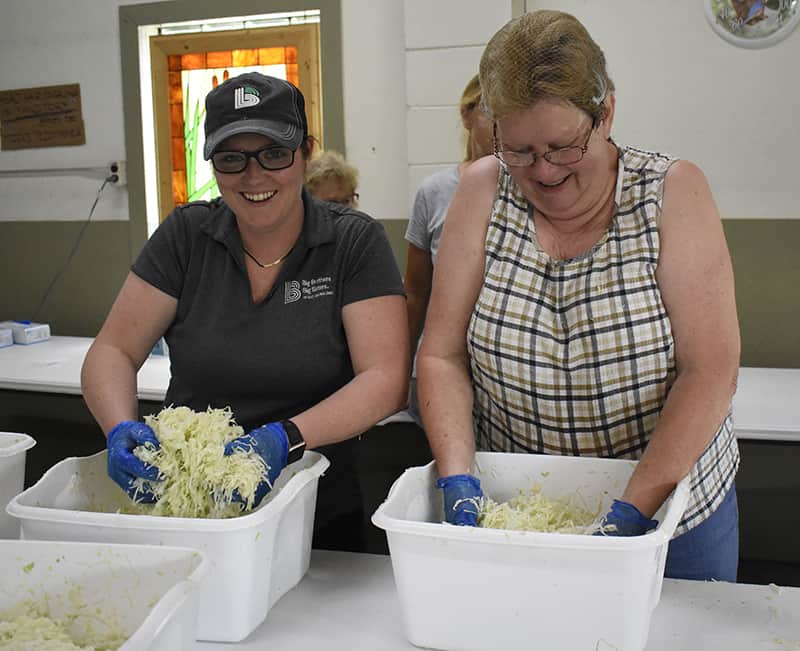330-476-6343 | [email protected]

330-476-6343 | [email protected]

Thanks to Big Brothers, Big Sisters, sauerkraut is ready, but comes with new guidelines
By Leigh Ann Rutledge
Associate Editor
With the return of the Algonquin Mill Festival comes sauerkraut.
When the sauerkraut supply ran out during the 2019 festival, the future of the longtime Mill favorite was uncertain. Due to COVID-19, the festival was cancelled in 2020. This year the festival will run Oct. 8-10. Sauerkraut will be available until the supply runs out.
A new group took over the processing and selling of kraut after Dave and Diane George, members of the Carroll County Historical Society, retired. The George’s of Minerva oversaw the sauerkraut operation for 20 years, calling it quits after the 2019 festival.
The historical society has a few minor changes which will be implemented at the sauerkraut house this year.
Big Brothers Big Sisters
Big Brothers Big Sisters (BBBS) of East Central Ohio, which serves Carroll and Tuscarawas counties, was approached regarding taking over the operation. When the CCHS reached out to Scio resident Bob Hendrix for assistance in finding an organization or group for the operation, Hendrix contacted BBBS. He was a “big” for several years and was a BBBS board member.
Beverly Pearch, BBBS president and CEO, met with Mike Mangun, Algonquin Mill Farm manager, who showed her the process through pictures and the group decided to take the venture on as a fundraiser.
Pearch hopes the venture will bring more awareness to the organization and program and get more “bigs” to sign up. Presently there are 10 children in Carroll County on the waiting list for community-based mentoring. A big donates four hours per month with their “little”.
“Things that are really simple make a difference,” Pearch said.
School-based mentoring is held during school hours at Carrollton and Malvern schools. Elementary and middle students are paired with high school students.
As for the mill and sauerkraut, Pearch said, “It’s been a lot of fun working with Mike and Jen (Cramer, society board president) and I’ve learned the mill history. The potlucks and fellowships are a really neat environment.”
Pearch, her staff and volunteers worked with historical society “sauerkraut veterans” over three days, preparing the cabbage to ferment.
They will gather prior to the festival to pack it in containers and work the sauerkraut house until it sells out.
Pearch saw the pictures and realized the society had the processing down to a science with assembly lines.
“We thought we had an idea, but not really,” Pearch stated, “until you see six tons of cabbage.”
Cabbage to Kraut
In 2019, the society started with nine ton of cabbage. With a new group learning the ropes, they processed six ton. Six skids filled with 50-pound bags of cabbage weighing one ton each arrived from New York to begin the process the second week in August.
Cramer gave a walk-thru tour of the sauerkraut making process. Bags of cabbage were brought to the pancake house to be prepped for fermentation. Volunteers, ranging in age from 17-82, stood at tables lining the outside walls of the building. Outside the building, volunteers Alan Weir and Regis Schilling, opened the bags and cleaned off the outer leaves before the heads of cabbage came inside. The bottoms were cut off and any remaining outer leaves or bruised areas were removed. The cabbage went down the line where it was cut into quarters and placed in machines where it was shredded.
The shredded cabbage was then placed in tubs, sprinkled with salt and mixed. Salt helps bring the juice out. Once it has been “juiced”, it is placed in a barrel and “stomped down” to compact it and bring out more juice. (The cabbage is not “stomped” like Lucy and Ethel, who used their feet to smash grapes, but with large, heavy wooden plunger-type sticks.)
The cabbage is transported to a climate-controlled building where the bags are sealed and trash bags full of water are placed on top. The pressure from the bags spread across the top keeps the juices working to ferment.
When they finished with the preparation process, they expected to have nearly 30 barrels, which will ferment for 6-8 weeks and be checked regularly.
The week of the festival, the group will gather to pack into containers. They will be stored in a refrigerated truck until they are sold. Having the refrigerated truck, society members are hoping to have all the sauerkraut packaged before opening day of the festival.
“It’s not hard, but it’s different physical labor,” Pearch noted of the process.
Changes
Due to the high demand and long lines at the sauerkraut house, the historical society has implemented minor changes regarding the sale of sauerkraut.
Quart containers of sauerkraut will be for sale for $6 each on a first-come, first-served basis. This year, there will be a limit of eight quarts per sale. Anyone wishing to purchase more than eight quarts, will be required to go to the back of the line and wait for another turn. The society will not hold orders or sell pre-sale. Anyone purchasing sauerkraut wishing to stay, should bring their own cooler for storage.
The Algonquin Mill Festival exhibits will be open 9 a.m. to 5 p.m. daily. The festival ground is located south of Carrollton on SR 332.
Interested in a monthl roundup of stories? Enter your email to be added to our mailing list.
